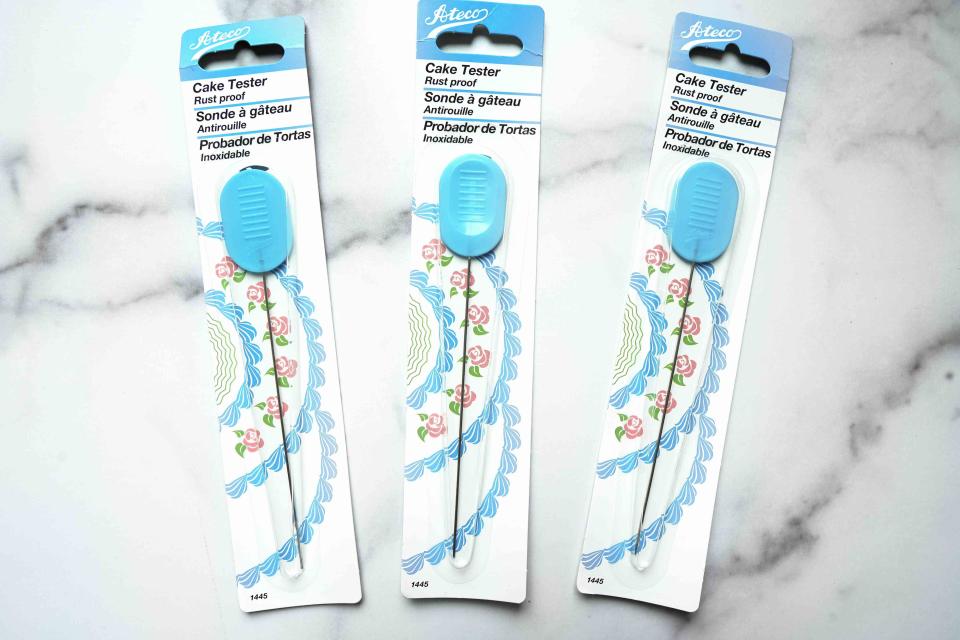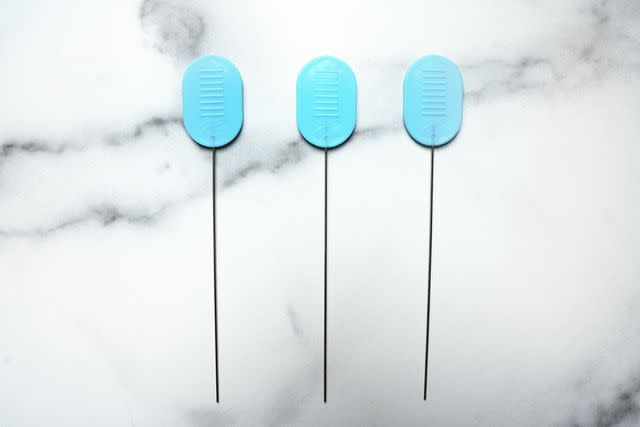What’s the Point of a Cake Tester?
Dotdash Meredith and Yahoo Inc. may earn commission or revenue on some items through the links below.
This inexpensive tool isn’t just for cakes.

Serious Eats / Riddley Gemperlein-Schirm
Potato peeler, steak knife, citrus juicer—some tools have such literal names that there’s no question as to their intended purpose. Cake testers are a great example. You pick up the pointy thing, stick it in a just-baked cake, pull it out, and check if it’s gooey or not. Simple!
But why not just use a toothpick instead of buying yet another tool? You definitely can, though not all baking experts agree that cake testers and toothpicks are equally up to the task.
“A toothpick has texture to it—a lot more than a skinny piece of steel—which can pick up crumbs on its way through a cake,” says chef and food scientist, Tiffany Swan. “To the untrained eye, these crumbs can make it look like the tester isn’t clean, and leaving the cake in the oven until the toothpick is completely clean will create an overbaked cake.”
You can also argue that the stainless steel probe of a proper cake tester is more durable than a toothpick, thus eliminating both the risk of wood splinters in your food and the wastefulness of tossing out toothpicks after using them for testing. Cake testers are also more all-purpose than you might think. Kenji wrote about their versatility years ago, and like any good classic, cake testers just don’t go out of style.
What’s a Cake Tester?
Ateco Stainless Steel Cake Testers (Set of 3)

Put simply, a cake tester is a thin metal skewer with a simple grip on the end. Cake testers are meant for subtle poking—usually into cakes, as the name suggests. The diminutive diameter of a cake tester leaves a barely noticeable hole (far more discreet than, say, using the tip of a knife) and the idea is that, toward the end of the baking time, a tester inserted into the center of a cake should come out nearly as clean as it went in. If it’s covered in batter, you know the cake hasn’t finished baking. But as Swan noted, the idea of what constitutes a “clean” tester is subjective.
A few moist crumbs clinging to your cake tester (or your toothpick) is really quite fine. The cake will continue to gently bake itself with residual heat after you’ve removed it from the oven anyway—if you wait until your tester is bone-dry, you may be asking for an equally arid cake. A cake tester isn’t a foolproof method of assessing doneness, but it’ll give you a pretty good idea.
What Else Can You Use a Cake Tester For?

Serious Eats / Riddley Gemperlein-Schirm
The cool thing about cake testers is that—aside from being inexpensive and taking up minimal space in your utensil drawer—they can be used for lots more than just testing cakes.
Cake testers can be especially helpful when working with delicate seafood, according to chef and dietitian Melanie Marcus MA, RD.
“My cake tester is my go-to tool when cooking scallops,” says Marcus. “They’re just one of those proteins that you don’t want to consume ‘under,’ because they’ll be slimy and unpleasant—but they’re just as easy to overcook.”
Marcus says that she inserts her cake tester into the scallop for about five seconds, then she does a wrist check. If the tester feels warm, she knows the scallop is ready. If it’s cold, she gives it another 30 to 60 seconds before retesting.
“I use the same method when cooking steak,” Marcus adds. “If it’s cold, your steak is rare. If it feels warm, your steak will be medium-rare, and if the tester is very hot, your steak will be well-done." (Editor's note: of course, we prefer an instant-read thermometer for this task, as we're all about accuracy.)
You can also use a cake tester to check vegetables (like boiled potatoes or roasted butternut squash). "Basically doneness of a lot of vegetables," senior culinary director Daniel Gritzer says of a cake tester's uses. "Anywhere a recipe might say to test doneness with a paring knife, a cake tester is arguably better since there's no blade edge/point that can cut and make something seem more tender than it is. This could include blanched vegetables, winter squash, broccoli, tubers, and root vegetables, etc." Our updates editor Jacob Dean agrees: he often uses a cake tester to test the doneness of potatoes. "It's a trick I picked up in Sweden," he says. "[It] works better than a knife, gives a much more specific tactile response for determining the texture."
Swan even uses her cake tester to apply labels on everything from dry goods to herb seedlings in her garden, by “placing a label over the plastic grip.” Clever! And Daniel has another unexpected use: "I use mine to clean the very thin space between my counter and [oven] range of any crumbs that have gotten stuck."
What cake tester should you buy?

Serious Eats / Riddley Gemperlein-Schirm
We recommend the Ateco 1445 cake tester for its slim profile, durability, and inexpensive price. You can even get a set of three for less than $10.
FAQs
Should you use a cake tester to test the doneness of cake?
You can! Cake testers are helpful for determining whether the center of your cake is properly set or not. It’s okay to use a toothpick instead—just be mindful that the wood’s natural texture may pick up a few extra crumbs and this doesn’t mean that the cake is underbaked.
What’s the best cake tester?
We prefer the Ateco 1445 cake tester. It's expensive and has a grippy, ridged plastic handle that makes it easy to hold onto.

